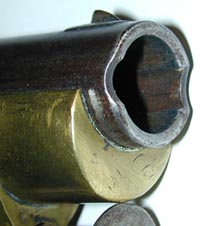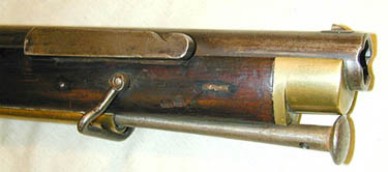You are here: Home > Firearms > British Military Longarms
Written by: Arthur Hare
The late Arthur Hare gives an illustrated history of this interesting rifle.
The Brunswick Rifle: Part 1 > Part 2 > Part 3 > Part 4
This curious arm with its two-groove bore and belted bullet remained in the hands of Regulars, Militia and Native troops for almost half a century, despite complaints of the guns inaccuracy and difficult loading system. The weapon replaced the seven-groove quarter-turn Baker rifle that had been in use for almost 25 years. The Baker in turn had replaced the old smooth-bore Brown Bess.

As well as an obvious requirement for improved long-ranged accuracy, there was also a need for a new ignition system to replace the old style flint action that had been rendered obsolete by the introduction of the percussion cap. George Lovell an Employee and later Inspector for Enfield dedicated himself to bringing the percussion system to the British military, and as early as 1831 began experimenting with various systems. On February 5th 1836, 2,000 new rifles were ordered by the Board, and George Lovell was instructed to provide a pattern similar to the Baker.

It was obvious that the Hanoverian oval bored rifle failed to impress Lovell, for the first model Brunswick he produced was rifled in the usual way, but with eleven grooves instead of seven. The twist of this rifling was increased to a three-quarter turn in the thirty inches of barrel. This, as he put it, was to give more rotation but less friction. The stock was not as straight as the Baker, in order to give a better aim, and the furniture was of iron, blued or case hardened to avoid the glitter of brass. Other features were a back-action percussion lock, and a fixed back-sight for 200 yards with a folding leaf for 300 yards (pictured).

The sword bayonet had a similar grip to the Baker hand bayonet, with a wide double-edged blade 17-in. long and was attached to a round lug near the muzzle.
The rifle was quickly put to the test. Officers of the Rifle Brigade were then invited to comment, but they seemed mainly concerned with the bayonet controversy. Lt.-Col. Eeles agreed that the new rifle should have a sword attached to the barrel “in the same manner that the swords were fixed during the time of the War.” In May 1836, Lovell was, in fact, instructed to prepare an experimental rifle with a sword bayonet. This bayonet has a blade 25-in. long and a knuckle bar. On the other hand another Rifle Brigade officer, Lt.-Col. Brown, advised a long light bayonet instead of the short sword formerly supplied to the Rifle Corps.

In the meantime, Mr. Seabright, acting on behalf of the Duke of Brunswick, had submitted a rifle, which was stated to have been developed by his Field Adjutant, Capt. Berners then in use by the Duke of Brunswicks forces. It had a barrel 3 ft. 3 ½ in. long with two wide grooves making a complete turn. Lovell tried it out against his eleven groove rifle and, although it was very similar to the Hanoverian rifle of 1835, he was immediately impressed. “Certain it is”, he reported, “that the shooting of this Rifle in my hands has been very excellent and I would therefore propose to make further inquiries into the principle upon which it is constructed.” The only objection he found was the difficulty of placing the belted ball in its proper position on the muzzle in loading.
Maj. Dundas and the Woolwich Committee were not so enthusiastic. They agreed the “it shot as well after 50 rounds had been fired from it as at the commencement of the day’s practice without having been once wiped out”. But they pointed out that a cartridge could not be used, and concluded: “This rifle is infinitely more correct in its firing at long ranges than the common rifle, but from the ball having less initial velocity, it requires a complication of sights which together with its great weight (10 lb. 7 oz.) and less facility in loading would render it very unmanageable for the use of troops in the field”.
On Boxing Day, 1836, Millar reported that the rifle had four great advantages over its rivals:
It was as accurate as the others at short distances, and superior at long distances. There was no difficulty in handling or loading it.It shot correctly for a longer period without cleaning.The greater smoothness of the barrel made it less likely to wear away than those with projecting bearings or lands.
In 1837 the decision was made to adopt the Brunswick system. The weapon was of .704 caliber with a 33 1/16 inch browned barrel incorporating a hooked breech The .704 caliber was chosen so that standard infantry musket balls could be used if necessary. The furniture which included a butt-box cover, ramrod pipes, trigger-guard, buttplate and fore-end cap were of brass.
The back-action was case hardened and the ramrod was polished bright. Lovell told the Board that he had second thoughts about the rifling of his new pattern rifle. One he had made with the two grooves in the style of the Brunswick had proved superior to the eleven-grooved model.

As the general design of the rifle had been agreed with the Rifle Brigade and orders had been placed for materials, the question of rifling was now urgent. During November and December, six of Lovell’s first model two groove rifles were given a searching test by a Committee of Officers under Maj.-Gen. Millar, Director of Artillery.
The rifle was similar in appearance to the original eleven-grooved model but it now incorporated the Brunswick rifling made to a caliber of .654 in. with the twist increased to a complete turn. Two of the faults to which the Committee had objected in the Brunswick specimen had been removed. Where the rifling left the muzzle, Lovell made two semi-circular notches into which the belt of the ball fitted a considerable help to loading.

The total weight was also reduced to approximately 9 lb. The bayonet had a more substantial handle and the blade was lengthened to 22 in.
The round lug on the barrel was replaced by the old flat bar (pictured below) with its notch towards the muzzle. It should be noted that Lovell moved this bayonet bar back from the muzzle so that when the bayonet was fixed, its guard was not in front of the muzzle – the main fault of the Baker.

The first bulk order for the setting up of 1000 rifles at Enfield was given on 25th October 1837. In January of the following year, it became apparent that 600 of these would be required urgently for Col. Brown’s Battalion of the Rifle Brigade and that the Enfield factory would not be able to supply them in time. The whole of the order was, therefore, put out to the trade in London at a charge of 38s per rifle. The first Brunswick rifles to be made were set up by the following gunmakers.
Tomas Potts
Wm. Heptinstall
Barnett & Co.
Reynolds & Son
Lacy & Reynolds
Yeoman’s & Son
E. J. Baker
Thomas Leigh
William Parker
W. Mills & Son
R. E. Pritchett
W. T. Bond
Thomas Ashton
212
55
212
55
210
55
146
55
80
55
80
55
80
It was ironical that these gunmakers should at the same time be fulfilling the last orders for the old flintlock rifles.
